Rising Sun: Weitere Modelle und Spielvorschau
Auf Facebook gibt es weitere Modelle für Rising Sun zu sehen, von Tempelhunden, über den Schildkröten Clan und albtraumhafte Oni, sowie erste Einblicke in die Spielmechanik.
The Komainu or Temple Dogs were traditionally found at the entrance to Shinto shrines, warding off any evil spirits that may try and enter. They’re believed to have great strength and above all, loyalty to those they fight with.
In Rising Sun, the Temple Dog is one of the many fierce creatures that may make an appearance and battle on the side of one of the warring clans.
These figures are resin, the finals will be plastic.
In Japanese culture, the turtle is one of the four Guardian Beasts that protect the city of Kyoto. The turtle fiercely fends off any attackers from the North.
However turtles have also begun to represent longevity and felicity among the Japanese. A minogame appears in many different legends and is a common motif in wedding ceremonies.
The Turtle clan has been around for as long as anyone can remember, and they defend their territory with the same ferocity and the mythical beast defends Kyoto. Today we introduce the Bushi from the Turtle clan.
These figures are resin, the finals will be plastic.
Turtles have a hard shell and a wise mind. They’re known for their slow and steady progression. The Turtle clan from Rising Sun holds the sentiment to heart, as they make their way across the country, laying waste to those in their path.
Today we continue our examination of the Turtle clan, with the Daimyo and the Shinto miniatures.
These figures are resin, finals will be plastic.
Hate is something that can live inside all of us. It corrupts, and leads to evil deeds. The Oni of Hate is the very embodiment of that emotion. In Rising Sun, you can actually control and unleash hate on your opponents. Just make sure you’re not on the receiving end of that barrage.
The Oni of Hate is one of the playable monsters in Rising Sun.
This figure is resin, the finals will be plastic.
The Oni of Skulls isn’t concerned with honor or pride, only victory on the battlefield. It is one of the playable monsters from Rising Sun that can be acquired and added to your military forces.
Stay tuned for more updates on Rising Sun and the March 7th launch of the Kickstarter campaign.
This figure is resin, the finals will be plastic.
In Japanese culture, the soul or tama, is not connected to the body directly. It permeates the world around the person, interacting with nature and bringing life and vitality to them. When the soul leaves the body they become sick and die, and the soul is released to move about the universe.
That is, unless they are collected by the Oni of Souls, who gains power from their energy. He is one of the menacing monsters that players can acquire and use in Rising Sun.
This figure is resin, the finals will be plastic.
The Rising Sun Kickstarter launches on March 7th at 3 PM EST.RISING SUN: GAME OVERVIEW
Throughout thousands of years of history, Japan has developed an incredibly rich culture based around, among many things, food, family, travel, and tradition. The Japanese mythologies and folktales largely embrace the Shinto and Buddhist traditions. They tell the tales of the many different Kami (Japanese Gods) and their exploits interacting with actual humans.
Prototype components of Rising Sun.
It was these mythologies that first caught the attention a young Eric M. Lang. As a kid, he would visit family in Germany. During these visits, he would often sit with his grandmother and look at picture books from different cultures. He remembers, even at a young age, being inspired by old Japanese folktales. Even though he couldn’t read the stories themselves, the aesthetics, emotion, and imagery of those tales have stayed with him all his life.
This fascination with Japanese mythology is what influenced his latest design: Rising Sun. Set in feudal Japan, players control hostile clans, struggling over territory. It is a war game, but one with a decidedly social and political feel to it. Players will go into battle, but in a very diplomatic fashion.
“Players are the leader of their clan and they’re trying to, not just conquer Japan, but to re-civilize it,” explains Lang. “The game is about the machinations of war, as much as the war itself.”
Politics plays a huge role in the game, with players getting the chance to form and break alliances. Finding the right time to join forces with another clan and determining when that partnership has run its course will be a big factor in a game of Rising Sun. Lang was going for almost a Cold War type of feel, where positioning, politics, and timing are all crucial factors in determining how to proceed.
“You have to make a conscious choice whether you want to go by yourself or you want to choose a player to share bonuses with.”
A game of Rising Sun is played over the course of four seasons. The first step of each season is the Tea Ceremony. This is where a lot of the social element of the game is played out. During the Tea Ceremony, players are able to form alliances for the upcoming season. There are advantages to teaming up, but you can’t attack someone you have an alliance with. So players must be careful not to ally with someone going after the same territories.
As polite and civilized as Rising Sun is, there will inevitably be battles. Lang has developed a combat system that is almost as political as the rest of the game. Because war is expensive, players have to save money. Before a battle takes place, players secretly invest their money. There are four different options, and players can try to win as many or few as they want. Once the bids are made, they are revealed and resolved. The forces at the start of the battle may change dramatically as players remove figures through seppuku, take hostages, or hire Ronin to join their army. After all of the bids have been resolved, the player with the most forces wipes everyone else off the board, and then it’s on to the next battle.
A game like Rising Sun, with its rich theme, incredible miniatures, and battle mechanics, will definitely draw comparisons to another title by Eric M. Lang, Blood Rage. In a way, that makes sense. Working on Rising Sun was a little like “getting the band back together.” Lang was rejoined by the same artist, in Adrian Smith, and Studio McVey, the team responsible for the memorable figures from Blood Rage. While there are similarities, both games have a very different feel.
“I envisioned Blood Rage as being part of a very loose series of games based on the folktales I loved growing up,” said Lang, who saw Rising Sun as the natural choice for a second game in the series. While he’s inspired by many different cultures, Lang doesn’t envision the series containing a huge number of games.
“Each one takes a long time to perfect, and I leave a piece of myself behind in every one of these big games that I do,” he explains.
In the coming weeks, we’ll be revealing more about how Rising Sun works, including a deeper examination of the innovative battle system, looking at the role diplomacy plays in the game, and how the art and aesthetics come together to create an immersive experience like never before. Rising Sun is one of the most personal games of Eric M. Lang’s career, and fans of his work are in for an exploration of the stories and culture of Feudal Japan that will stay will them long after the last season has ended.
DIPLOMACY IN RISING SUN
Diplomacy is to do and say the nastiest things in the nicest way. -Isaac Goldberg
Most war games focus on building up military forces and finding strategic ways to deploy them. Players are tasked with finding the weak spots in their opponent’s defensive lines and exploiting them. But they must always deal with the fog of war, never really knowing what’s going on in the minds of the people they hope to destroy. Rising Sun is a game that definitely has a war element to it, but it also offers the new challenge of finding ways to ally with opponents and work together, at least, for a time. In fact, diplomacy and negotiation affect every aspect of the game, from the actions players take, to the alliances that are formed, to the battles that are waged.
Prototype boards for the clans in Rising Sun.
Over the course of three seasons, players lead their clans to conquer feudal Japan. Each season ends with battles taking place in different pre-determined provinces. However, that doesn’t mean that peaceful negotiation is not possible. Each season opens with the Tea Ceremony phase of the game. This gives players a chance to form an alliance that may last for the entire season. Deals can be made between any two players, but there is a lot to consider before joining forces.
“You have to make a conscious choice, whether you want to go by yourself or you want to choose a player to share bonuses with,” said Rising Sun designer, Eric M. Lang.
Diplomacy and partnerships can manifest in many different ways in Rising Sun. During the game, players take turns selecting political mandates that allow everyone to take actions. However, the active player and their allies get a bonus associated with the action as well. For example, if a player chooses to Marshal, everyone gets to add a non-Daimyo figure to the board and make a troop movement, but the active player and their allies have the option to recruit their Daimyo.
Even if players aren’t allies, they can still make deals and barter to try and come up with a scenario that benefits them both. The order the political mandates come out can be important, so players may want to influence the decisions of others. Bribery is allowed, and even encouraged.
Lang explains, “I didn’t make rules about how to negotiate those partnerships. It’s wide open and free wheeling.”
That sort of open negotiation can sometimes favor players that are a little better at talking a good game. However, Lang was careful over the course of his design to not let the social aspect become too important.
“Even if you get out-partnered all game, if you play really well, you should be able to do better than somebody who just out negotiates you, but plays badly.”
Working in the element of alliances and diplomacy to Rising Sun was an interesting challenge for Lang. He designed the political dynamics between the players to work their way into every decision. It ends up being a tense balancing act between cooperation and aggression.
“I wanted the reason for these forced partnerships to become emergent after a few rounds,” said Lang, noting that the more players are exposed to those partnership possibilities, the more working together to achieve certain goals makes sense.
Trust is an important element when you decide to team up with someone, and whenever there is trust, there is the potential for betrayal. One of the political mandates only benefits the active player. They gain a great deal, but they’ll lose honor in the process and break any alliances they had. In Rising Sun, players are not bound to any verbal agreements they make, but they’ll have to weigh short-term benefits against the loss of trust in the long term.
Diplomacy is perhaps the most important when it comes to war. For each conflict that takes place, players secretly bid money on four different battle actions. Only one person will win each bid, so anticipating, or even talking about what each player hopes to do, is a good strategy.
“It behooves players to discuss what they want out of war before committing their bids,” said Lang. “Those who coordinate well, will get favorable outcomes for less money.” That is, of course, assuming you can trust the person you just made a deal with.
Lang has succeeded in creating an entirely new game experience in Rising Sun that is both innovative and intuitive. It’s not long before players will start to see the true potential of negotiation.
“When you play even one season of the game, you start to see the positions and why you’d want to ally with one player over another,” said Lang.
It’s entirely possible to play a game of Rising Sun never joining forces with another player. But the addition of that strategic possibility is extraordinarily enticing. It completely supports Lang’s desire for Rising Sun to be a polite and civilized war game. We may kill each other on the battlefield, but there’s no need for us to be brutes about it.
THE BATTLE SYSTEM OF RISING SUN
The greatest victory is that which requires no battle. – Sun Tzu, The Art of War
For centuries, disputes in Japan were characterized by small tribal battles. It wasn’t until the twelfth century, after the Mongols had been repelled, that armies grew to massive sizes and true war took place. This was the start of the Feudal period. Daimyo and Shoguns led their armies onto the battlefield and waged war on one another in attempts to install their own government.
Rising Sun prototype components.
As is always the case with war, money played a huge role. Consider for a moment, the type of operation you’d need in place to march an army of thousands of soldiers several hundred miles to do battle. Of course, you’d need to make sure each warrior was armed, and ideally they’d also have some sort of armor. However, you wouldn’t want to march them for days, just to have them collapse on the battlefield from hunger and exhaustion, so you’d need to ensure they were able to eat and get rest as well. All of this is not cheap and you quickly begin to see what an expensive endeavor war is.
In Rising Sun, money plays a huge role. Whether you’re winning or losing a battle, it’s going to cost you. However, when war does break out, players can freely negotiate, or even bribe each other to find a scenario that works for all parties. A wise warrior finds the solution that will cause the least bloodshed and cost the least amount of money. It’s great when a deal can be struck, but if that deal seems too good to be true, players should question if they can really trust their opponent to hold up their end of the bargain.
At the start of each Season, a certain number of Japanese regions are revealed. These are the locations where war will take place at the end of the round. Battles will be won or lost with the forces players are able to assemble. They can call upon Bushis, Shintos, their Daimyo, and a wide assortment of monstrous figures pulled right from Japanese mythology. During the Season, players have time to muster their forces and prepare for battle, or to see the coming storm and get out of the way. By knowing where and when the battles will take place, there is a slowly growing intensity to the coming resolution. You will start to see the importance of standing your ground in certain confrontations, or turning tail and running.
“I wanted a game that was very Cold War-like,” says Eric M. Lang, the designer of Rising Sun.
Politics are intertwined into every aspect of the game including the combat. When your forces are involved in a battle, you have four different options to invest your money in to. Anticipating what your opponents may want can lead to some creative bluffing or to a negotiated deal. Diplomacy plays a huge role in Rising Sun, and players are freely able to discuss where they intend on investing their money in a battle. Agreements can be made and equitable solutions found. Of course, you’ll never know if you’re able to trust your opponents until the bidding is revealed.
The first choice is Seppuku. You kill all of your forces in the region and gain honor for each of your figures killed in this fashion. This is an excellent option if it looks as if you won’t be able to survive the battle and you want to save some face.
Taking a Hostage is the second choice. This allows you to remove an opponent’s figure from the board, and lets you to steal victory points from them in the process. Your opponent will have to pay a ransom if they hope to get their soldier back.
The third option during a battle is to add your Ronin tokens to your forces already on the board. These tokens are gained throughout the game. Ronin were samurai warriors without a master. They were hired swords, willing to fight for anyone… for a price.
Hiring an Imperial Poet is the final option for how you spend your money in a battle. Great battles are all about the way they’re remembered in history. For that you need a poet. The winning bid will earn that player victory points for each figure killed in the battle regardless of their clan.
After the last battle action is resolved, the player with the strongest force in the region wipes out everyone else. The trick is that for each different battle that occurs, players will assign their bids secretly. They may try to win all four of the different battle actions, or put all their money on one. However, over the course of a Season, there will be several battles. If you’re involved in more than one, you may want to be careful how you spend your money.
“It was important for the war to feel as diplomatic as the political phase. The only difference is the consequences are death,” says Lang. However, it’s been his experience through the play testing process that even the battles are usually quite polite. The battle system requires players to be thinking several moves ahead, but the results are not determined by the roll of a die. Rather, they require the deftness and careful planning of a true leader. Nothing in Rising Sun happens by chance.
“What I wanted for the battle system, is that no matter what, somebody could get something out of every battle,” explains Lang. “It was meant to be more meditative, to support the vibe of the overall game.”
It wouldn’t be an Eric M. Lang and CMON game without some pretty cool monsters to add to the fray. Throughout the course of the game, players will be able to acquire creatures pulled right from the pages of Japanese mythologies to aid them in their conquests.
There’s the River Dragon, the Komainu, and a number of different spirits, like the Oni of Blood, or the Oni of Skulls. Each monster is represented by an incredible, highly-detailed figure. Once they’re placed on the board, opponents better beware. Used effectively, these monsters can swing the tide of a battle.
Rising Sun offers a remarkable gaming experience. It is a balancing act between war and partnership for the players. Sometimes the carrot offered is diplomatic relations, at other times a more pointed stick and violent tactic is required to get your way. Everything in the game is tied together, including Lang’s unique new battle system. The key is to find a peaceful solution, until you’re ready for war.
Rising Sun launches on Kickstarter on March 7th at 3 PM EST.
Quelle: Rising Sun auf Facebook


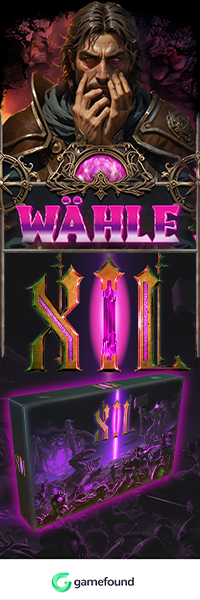
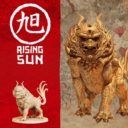
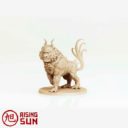
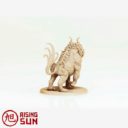
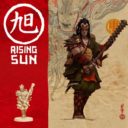
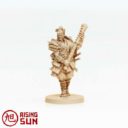
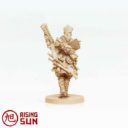
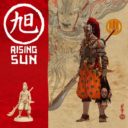
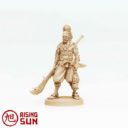
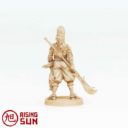
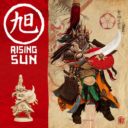
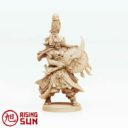
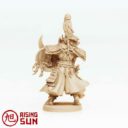
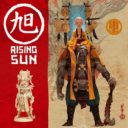
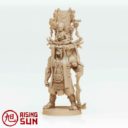
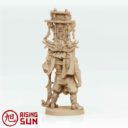
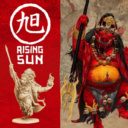
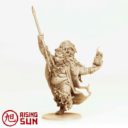
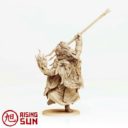
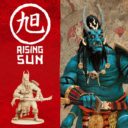
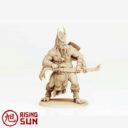
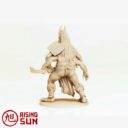
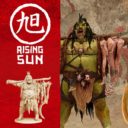
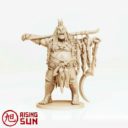
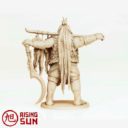





Wow! Da haben die noch mal eine gewaltige Schippe drauf gelegt. Aber aufgrund der weicheren Konturen vermute ich, dass die mit der Hand gemacht wurden.
Haha, Rising Sun mit dem Titanforge-Kickstarter verwechselt
Wow – diesmal sind „meine Jungs“ dabei. Die Onis (Schildkrötenklan eingeschlossen 😉 ) sind wirklich schick.
Und ein weiterer toller Komainu. Wobei ich verrückt finde, dass das Gesicht des Modells so extrem menschlich wirkt, das Gesicht bei der Illu aber nicht, obwohl sie sich so wenig unterscheiden.
Sehr bedauerlich: jedes einzelne der Artworks und jeder Resinmaster hätte einen Verweis auf den Künstler verdient. Es sthet aber (leider wieder einmal) CMON über Allem.
Sympathiebonus gibt es dafür nicht.
Ein sehr guter und wichtiger Punkt. Auch ganz allgemein.
Wobei: dass Adrian Smith hier malt, dürfte allein schon an seiner „Handschrift“ klar sein. Auch den ein oder anderen Kneter erkennt man sehr gut – Alan Carrasco oder Kev White um nur zwei zu nennen. (Wohlgemerkt: die Kneter hier aber nicht – nicht, dass falsche Gerüchte aufkommen… 😉 )
Sowas finde ich sehr cool. Andererseits, wieso sollte man unnötig Geheimnisse daraus machen? Spieleschreiber werden ja auch oft genannt.
Da sind übrigens Mierce Miniatures vorbildlich und sehr loyal ihren „Künstlern“ gegenüber: die nennen so gut wie immer Konzeptmaler, Modellierer und Bemaler.
Artworks sind von Adrian Smith. Genauso wie bei Bloodrage.
Hat dir CMON eigentlich persönlich mal was negatives angetan oder wieso kommt da von dir immer regelmäßig ein negativer Kommentar?
Persönlich haben mir CMON überhaupt nichts getan. Sie verramschen in meinen Augen aber mitunter wirklich große Kunst. Das finde ich bedauerlich. Ist aber scheinbar populär und lukrativ 🙂
Die Auslagerung von Figurenguss nach Fernost ist dabei nur ein Punkt, der in meinen Augen den nötigen Respekt sowohl vor der Arbeit der Künstler, als auch vor der der Formenbauer und Giesereien hier vor Ort vermissen lässt.
Make Firguren giessen great again! Europe first 😉
@Chico:
Ohne 😉 hätte ich jetzt schonmal den Kaffeebecher auf der Feststelltaste geparkt 😉
Die armen Künstler wurden sicher zu einer Zusammenarbeit gezwungen von CMON. Sitzen irgendwo eingespeert und schauen hilflos zu wie die eigene Kunst zum Chinaprodukt wird.
Alter, sind das geile Modelle. Uff….
Kauft mehr Met!
(Ich brauche das Geld… 😉 )
Ich hab zuerst Mett gelesen…als ich dann Met sah, wars leider nur halb so lustig. Aber immernoch geil!
Wie neulich schon jemand sagte zeigt hier Adrian Smith mal wieder, was er drauf hat! Die Figuren konnten bisher immer nicht so recht die Artworks einfangen, diese Modelle hier sind aber schon deutlich näher ran!
Sehr cool, ich freue mich aber noch mehr auf CMON’s Brettspiel vom Paten.